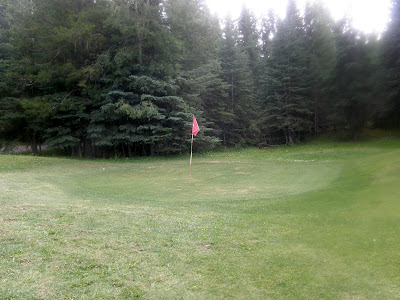 |
| Gord's drive on number 1 |
On july 5th, I played the
Cardiff Golf & Country Club at the invitation of the head golf professional Shaun Westhaver. As I was on my own, I was joined by Ed, Gord and Jim, a trio of local golfers and course marshalls who happily and proficiently guided me throughout a most pleasant round.
Built on the site of Alberta's first underground coal mine dating back to 1895, Cardiff was designed by John and William Robinson who have also signed Lewis Estates Golf Course in Edmonton. William is also the architect of the Creek at Qualchan, in Spokane, which I played two weeks ago. Cardiff offers a good but difficult layout playable by golfers of all skill levels thanks to four different sets of tees. It plays at 6889 yards from the back down to 5246 yards from the red which would make it quite attractive for ladies.

The first impression is that of a fairly flat layout when sitting on the first tee box (pictured above). But then, number four here on the right offers some undulation and when you get to number ten you face a serious elevation to a quasi blind green. The fairways are routed amongst clusters of mature trees that often come into play as on number 1. If you look at the top picture, you will see that the first drive has to split the fairway between two clumps of trees before it finds a landing area also protected by two sand traps on the right of a fairway that then doglegs left. Stretch that hole to more than 400 yards for an opening par 4 and you will understand why it is the most difficult hole on the course

There are very few water hazards at Cardiff and perhaps only one that really comes into play seriously and that would be on number 11 where your drive should seek the left side of the fairway. Anything right is in grave danger of finding the pond as I did, of course. It is not that long nor that difficult a hole but as it doglegs right you get tempted to cut the corner, and if you are a bit short, particularly in the wind, which was pretty strong that day, it is a risky shot. As I said earlier, this course is more difficult than it looks and deserves some respect.

Cardiff is in really good shape, the fairways are generous and receptive. The greens are impeccable, neither slow nor fast, they roll true and with predictability. You would have to play them more than once to understand the breaks. I would see breaks where there were none, and play half the break needed when there was an obvious one. I have read somewhere, or have been told that, because the course was built over an underground mine, the greens still shift and, consequently, the breaks and undulations are never the same from year to year. It is most likely a myth, but nonetheless a fascinating one.
Cardiff Golf & Country Club is well worth visiting and fun to play. I invite you to visit their
website and to take advantage of their Monday discounted rates ($29), the best golfing deal to be had around Edmonton. And don't forget to claim your free birthday green fees.
 |
| View off number 5 tee box. |


 Eagle Rock is a championship course of moderate length playing at 6590 yards from the back tees and 5967 from the whites. The front nine has two rather short par fours of less than 300 yards. The back nine plays longer and has more treacherous water hazards. All the par 3's are fairly long and are consequently more demanding for the average golfer, making up for the short par 4's. I played rather well on the front nine, gaining some confidence in my game. I had one really bad hole on the back nine along with far too many bogeys. I still managed an 87 which was my best round in a long time.
Eagle Rock is a championship course of moderate length playing at 6590 yards from the back tees and 5967 from the whites. The front nine has two rather short par fours of less than 300 yards. The back nine plays longer and has more treacherous water hazards. All the par 3's are fairly long and are consequently more demanding for the average golfer, making up for the short par 4's. I played rather well on the front nine, gaining some confidence in my game. I had one really bad hole on the back nine along with far too many bogeys. I still managed an 87 which was my best round in a long time.























